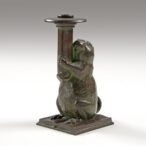This is the final Sunday in the season of Epiphanytide. The season of Christmastide ended earlier in the week on February 2nd with the feast of the Purification. This feast occurs precisely 40 days after Christmas because, according to the Mosaic Law, a woman must go to the temple to be purified 40 days after the birth of a son (80 for a daughter).
This is also the feast of the Presentation of the Child Jesus in the Temple, Candlemas, and Groundhog Day.
Wait! Groundhog Day? Yes, indeed. And it is not a coincidence. Candle processions on February 2nd were customary in ancient Rome to mark the midpoint between the solstice and the equinox. These were effectively Christianized and associated with the Christian holy day of the Purification and Presentation.
Meanwhile, a folk custom developed throughout Europe of predicting the weather on Candlemas. Generally, if Candlemas were sunny, that would presage a longer winter. The German lore would observe the following.
Sonnt sich der Dachs in der Lichtmeßwoche, so geht er auf vier Wochen wieder zu Loche.
If the badger sunbathes during Candlemas-week, for four more weeks he will be back in his hole.
German immigrants brought the custom into Pennsylvania, though they adopted the indigenous groundhog in place of the badger.
Similar proverbs exist in all European countries and many other countries throughout the world. This is one of several variations from England:
If Candlemas be fair and bright, Come winter, have another flight. If Candlemas bring clouds and rain, Go winter, and come not again.
Every Italian village and town seems to have its own version. One that is common in Rome:
Per la santa Candelora se nevica o se plora dell’inverno semo fora.
For the feast of Candlemas, if it snows or rains, we’re done with winter.
Because Candlemas had occurred earlier in the week, we had the possibility to solemnize the feast and celebrate that Mass in lieu of the Sunday. This would have included the blessing of candles and a candle procession before Mass. We chose not to do so because this was the Sunday on which we also have our Holy Name Society observances. We sang the Mass of the Fifth Sunday after Epiphany, the propers of which come from the Third Sunday after Epiphany.
Father was wearing green – an indication that this was an ordinary Sunday, not a feast, and so we sang Mass XI (for Sundays Throughout the Year) and Credo I.
For the processional, we sang God of Mercy and Compassion with a mind toward upcoming Septuagesima and Lent. At the Offertory, we did our usual Stella Coeli Extirpavit.
For the Communion, we did Jesu Dulcis Memoria, and for the recessional, we sang We Stand for God, both in honor of the Holy Name.
Since we had the feast of Saint Blaise earlier in the week, after Mass, Father blessed throats, during which time we sang the Magnificat, and the mixed Choir sang Alma Redemptoris Mater. Normally it is not so fitting to sing this Marian Anthem outside of Christmastide. We did so due to what would take place subsequently, the blessing of candles, which would normally take place on Candlemas. As is done after the blessing, we sang Lumen ad Revelationem Gentium.
Now you know why there exist candle holders like the one shown in the image.
